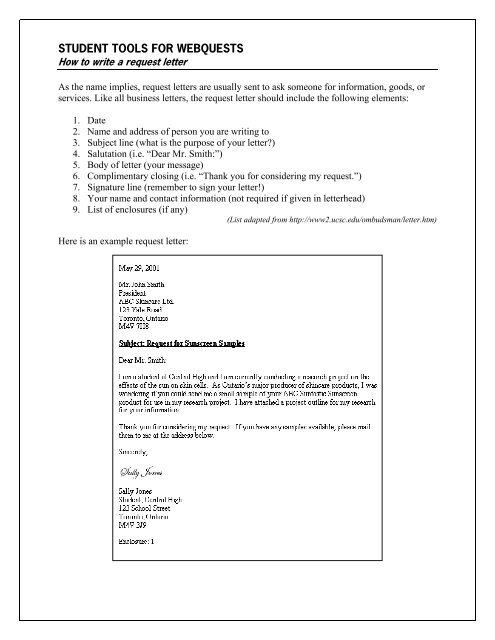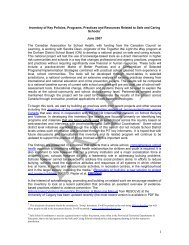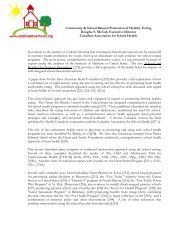Write a request letter - Communities and Schools Promoting Health
Write a request letter - Communities and Schools Promoting Health
Write a request letter - Communities and Schools Promoting Health
Create successful ePaper yourself
Turn your PDF publications into a flip-book with our unique Google optimized e-Paper software.
STUDENT TOOLS FOR WEBQUESTS<br />
How to write a <strong>request</strong> <strong>letter</strong><br />
As the name implies, <strong>request</strong> <strong>letter</strong>s are usually sent to ask someone for information, goods, or<br />
services. Like all business <strong>letter</strong>s, the <strong>request</strong> <strong>letter</strong> should include the following elements:<br />
1. Date<br />
2. Name <strong>and</strong> address of person you are writing to<br />
3. Subject line (what is the purpose of your <strong>letter</strong>?)<br />
4. Salutation (i.e. “Dear Mr. Smith:”)<br />
5. Body of <strong>letter</strong> (your message)<br />
6. Complimentary closing (i.e. “Thank you for considering my <strong>request</strong>.”)<br />
7. Signature line (remember to sign your <strong>letter</strong>!)<br />
8. Your name <strong>and</strong> contact information (not required if given in <strong>letter</strong>head)<br />
9. List of enclosures (if any)<br />
(List adapted from http://www2.ucsc.edu/ombudsman/<strong>letter</strong>.htm)<br />
Here is an example <strong>request</strong> <strong>letter</strong>:
In a <strong>request</strong> <strong>letter</strong> sent to a person or organization, you should try to state your <strong>request</strong> in the first<br />
sentence. You should explain who you are <strong>and</strong> why you are writing to him/her/them in the first<br />
place.<br />
In the body of the <strong>letter</strong> you should:<br />
• explain exactly what you are asking them to do<br />
• include background information or web links for them to retrieve more information<br />
• briefly describe the project you are working on<br />
• give your school’s address <strong>and</strong> telephone number for future contact; do not use your<br />
personal address or telephone number<br />
• be sure to thank them for considering your <strong>request</strong><br />
When writing a <strong>request</strong> <strong>letter</strong>, you may also wish to consider the following tips<br />
(http://www.writinghelp-central.com/):<br />
• Keep the <strong>letter</strong> short <strong>and</strong> to the point. Letters should be concise, factual, <strong>and</strong> focused.<br />
Try to never exceed one page or you will be in risk of losing your reader. A typical <strong>letter</strong><br />
page will hold 350 to 450 words.<br />
• Focus on the recipient’s needs. While writing the <strong>letter</strong>, focus on the information<br />
requirements of your audience, the intended addressee. Imagine the intended recipient<br />
seated across a desk while you are explaining the subject of the <strong>letter</strong>. What essential<br />
information does that person need to know through this communication?<br />
• Summarize your <strong>request</strong> in the first or second sentence.<br />
• Use simple <strong>and</strong> appropriate language. Your <strong>letter</strong> should use simple, straightforward<br />
language for clarity <strong>and</strong> precision. Use short sentences <strong>and</strong> don’t let your paragraphs<br />
exceed three or four sentences.<br />
• Re-read <strong>and</strong> revise the <strong>letter</strong>. Do a first draft of the <strong>letter</strong> <strong>and</strong> then carefully review <strong>and</strong><br />
revise it. Put yourself in the place of the addressee. Imagine yourself receiving the <strong>letter</strong>.<br />
How would you react to it? Would it answer all of your questions? Does it deal with all<br />
of the key issues? Are the language <strong>and</strong> tone appropriate? Sometimes reading your <strong>letter</strong><br />
out loud can be helpful.<br />
• Check spelling <strong>and</strong> grammar. A <strong>letter</strong> is a direct reflection of the person sending it, <strong>and</strong><br />
by extension, the organization that person works for. When the final content of the <strong>letter</strong><br />
is settled, make sure that you run it through a spelling <strong>and</strong> grammar checker. Sending a<br />
<strong>letter</strong> with obvious spelling <strong>and</strong> grammar mistakes looks sloppy <strong>and</strong> unprofessional. You<br />
may also want to ask a friend to proofread your <strong>letter</strong>.<br />
Once you receive a response or fulfillment of your <strong>request</strong>, be sure to send a thank-you <strong>letter</strong> to<br />
your contact person.<br />
2












